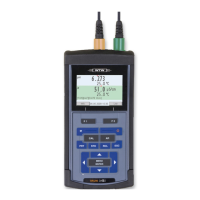
Do you have a question about the wtw Multi 3620 IDS and is the answer not in the manual?
| pH range | 0 to 14 pH |
|---|---|
| ORP accuracy | ±0.3 mV |
| Temperature resolution | 0.1 °C |
| Temperature accuracy | ±0.1 °C |
| Protection class | IP67 |
| Display | Graphic LCD |
| pH resolution | 0.001 pH |
| pH accuracy | ±0.005 pH |
| ORP resolution | 1 mV |
| Temperature range | -5 to 105 °C |
| Conductivity range | 1000 mS/cm |
| Salinity range | 0.0 to 70.0 PSU |
| TDS range | 0 to 1999 mg/L |
| Memory | 5000 data sets |
| Interfaces | USB |
| Power Supply | 4 x AA batteries |
| Oxygen Measurement Range | 0 to 50 mg/L |
Introduction to the Multi 3620 IDS meter and its capabilities.
Details about IDS sensors, their features, and data transmission.
General safety information and warning symbols used in the manual.
Guidelines for authorized and safe operation of the meter.
Lists all items included in the package with the Multi 3620 IDS.
Describes the different power supply options available for the meter.
Step-by-step guide for initial setup and commissioning of the meter.
Overview of basic operating principles and user interface.
Steps to power on the meter and prepare it for measurement.
Procedure for safely powering down the meter.
How to log in using a user name when user administration is active.
General principles for navigating through menus and settings.
How to perform pH measurements using the meter.
Importance and procedure for calibrating pH sensors.
Explanation of the CMC function for real-time quality control of pH measurements.
Overview of the QSC function for assessing sensor condition.
How to perform ORP measurements with the meter.
Information on checking ORP electrodes, as they are not typically calibrated.
How to perform Dissolved Oxygen (D.O.) measurements.
Procedure for checking the FDO® 925 D.O. sensor.
Importance and procedure for calibrating D.O. sensors.
How to perform Conductivity measurements with the meter.
Explanation of temperature compensation methods for conductivity.
Importance and procedure for calibrating conductivity sensors.
How to perform Turbidity measurements.
Importance and procedure for calibrating turbidity sensors.
Introduction to the Depth of Immersion (DPT) parameter.
How to measure depth of immersion.
Settings related to depth of immersion measurements.
Configuration options for pH measurement parameters.
Configuration options for ORP measurement parameters.
Configuration options for Dissolved Oxygen (D.O.) measurement parameters.
Configuration options for Conductivity measurement parameters.
Configuration options for Turbidity measurement parameters.
Settings not specific to any sensor type.
How to reset sensor and system settings.
Steps for manually storing measurement data.
How to configure automatic data saving at set intervals.
Overview of managing stored measurement data.
Steps to connect the meter to a PC for data transfer.
Connecting USB storage or printers to the meter.
Specifics on transmitting data to USB memory devices.
General maintenance activities for the meter.
How to clean the exterior of the measuring instrument.
Guidelines for the proper disposal of the meter and batteries.
General troubleshooting advice and common error indicators.
Troubleshooting specific issues with Dissolved Oxygen measurements.
Troubleshooting specific issues with Conductivity measurements.
Troubleshooting specific issues with Turbidity measurements.
General specifications of the meter, like dimensions and weight.
Technical specifications for measurement ranges, resolution, and accuracy.
Steps to update the meter's firmware via PC.
Steps to update the firmware of connected IDS sensors.
Definition of how to manipulate a measuring system for accuracy.
Definition of comparing and adjusting a measuring system's value.
Oxidation-reduction potential caused by substances in water.
Measure of acidity or basicity of an aqueous solution.
Restoring settings to original condition.
Smallest difference between displayed measured values.
Function to control measured value stability.